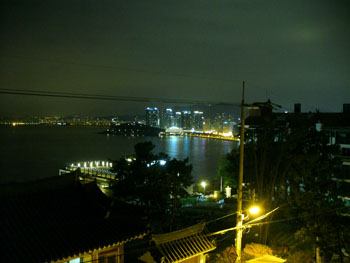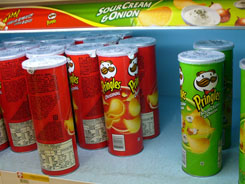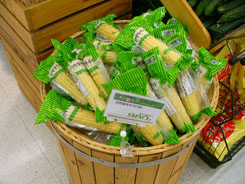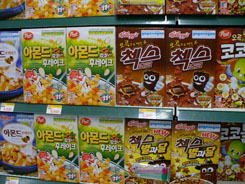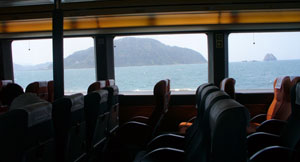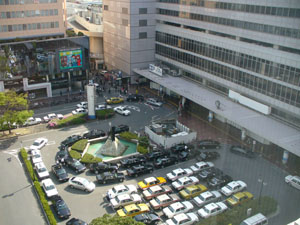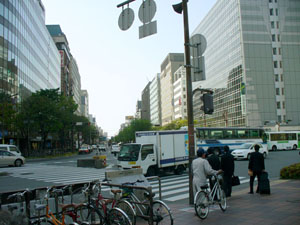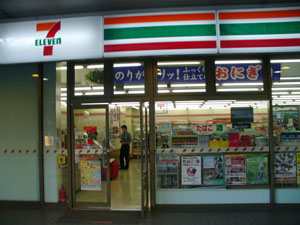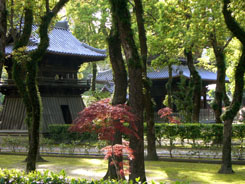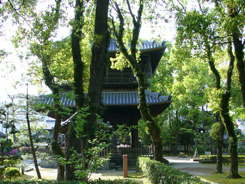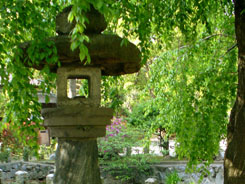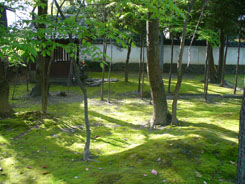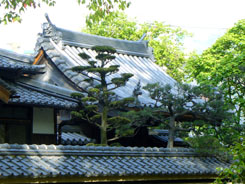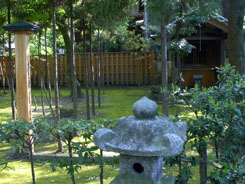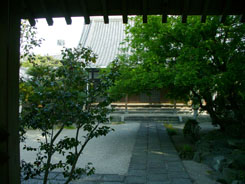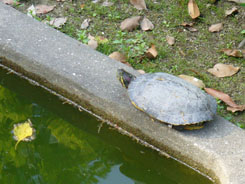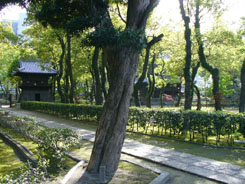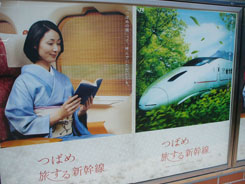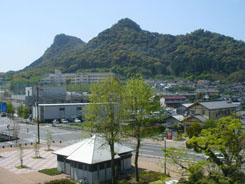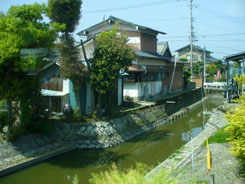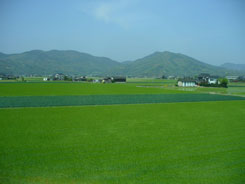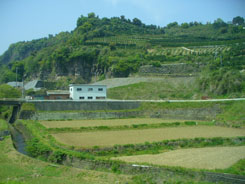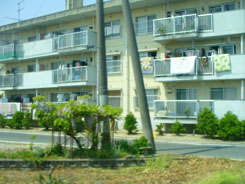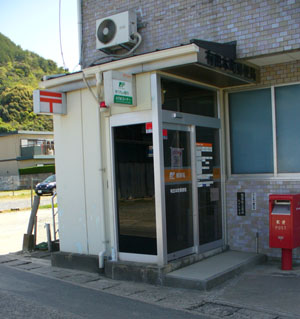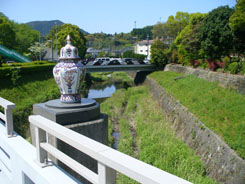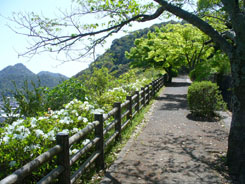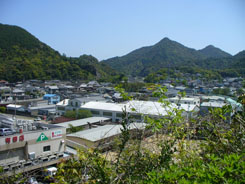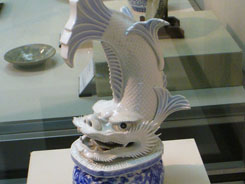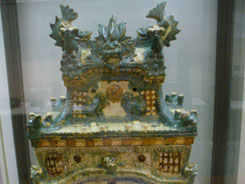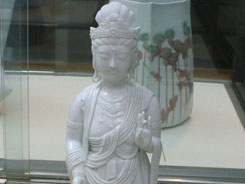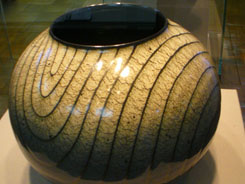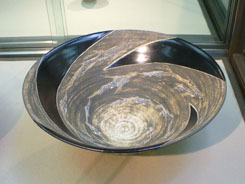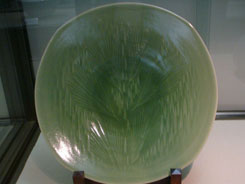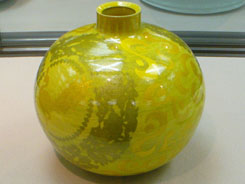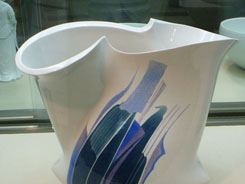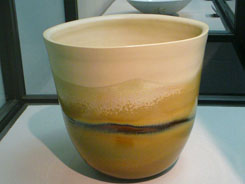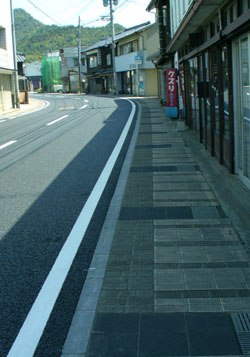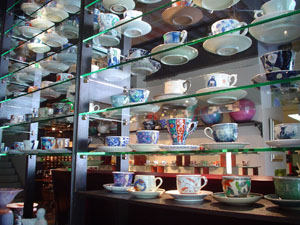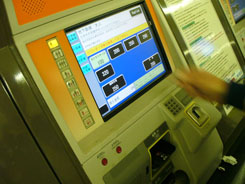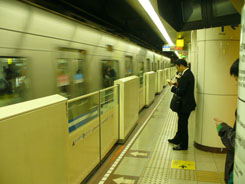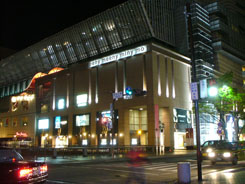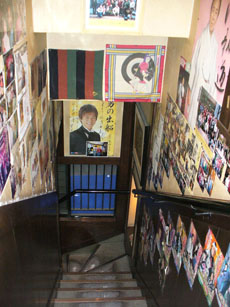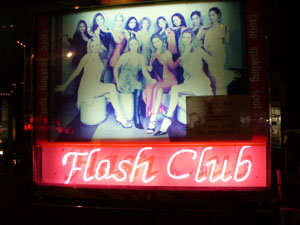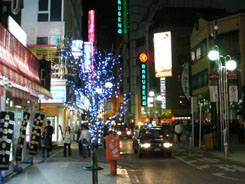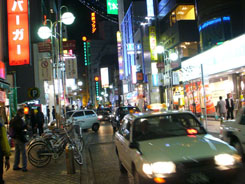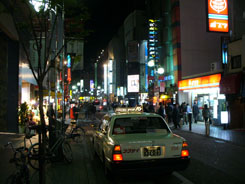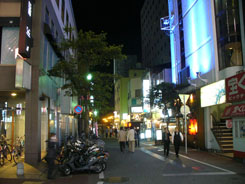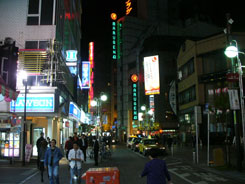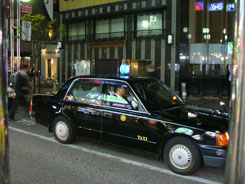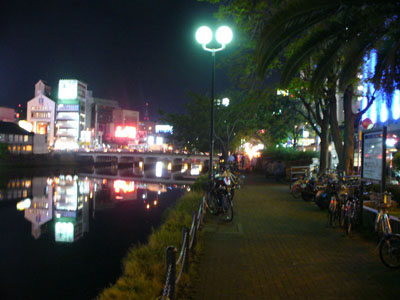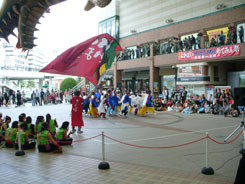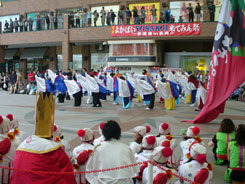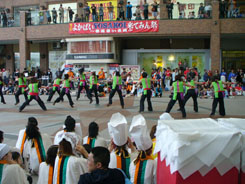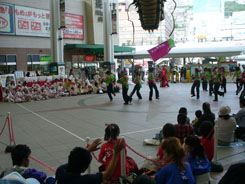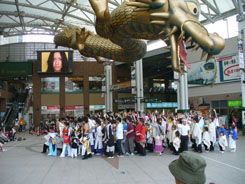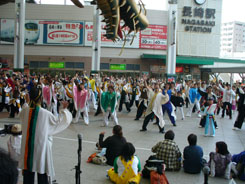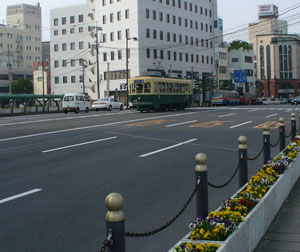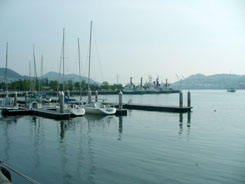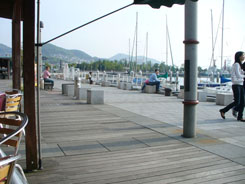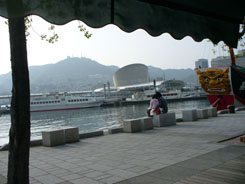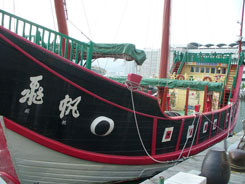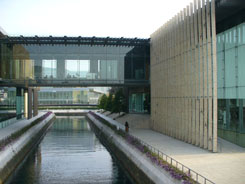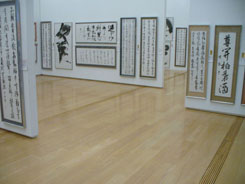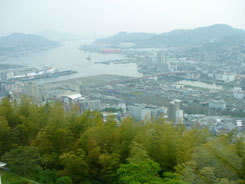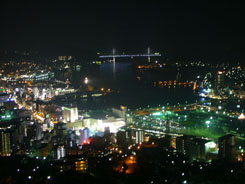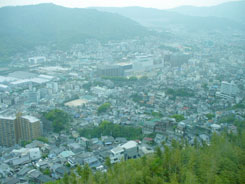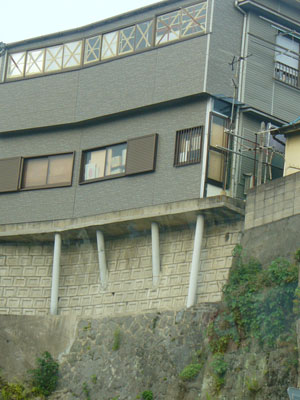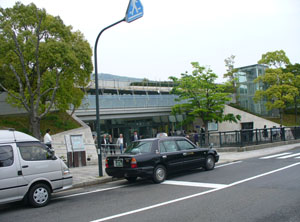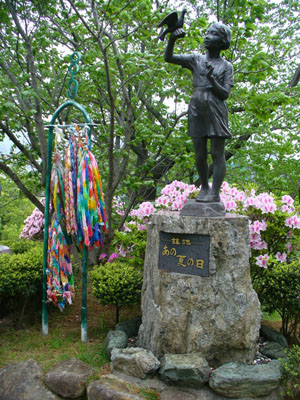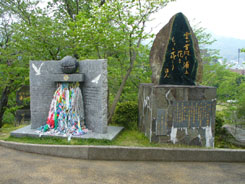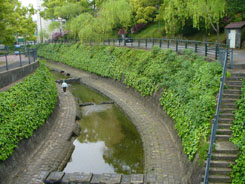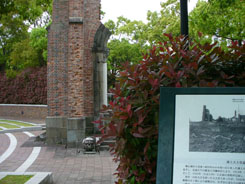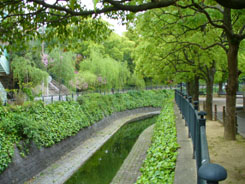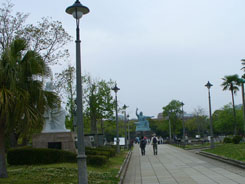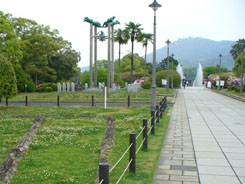This is the journal of my 2009 visit to Korea and Japan.
My earlier Africa Journals are here
Click the photos for large versions
I'm a web developer. Email me for a quote.
2) Fukuoka, Arita, and Nagasaki, Japan
3) Korea Road Trip: Busan to Seoul
Thursday, April 16, 2009 : Busan, South Korea
Rob took a lot longer than expected to escape his office but, at last, we are on our way. Even so, we stop on base to use a cash machine and Rob takes USD$400. I think it's a waste of time because we'll just use ATM machines in Japan to get Yen, but Rob thinks it's best to have US dollars in cash in reserve. Whatever.
The freeway is in perfect condition. And it often runs close to the high speed rail track up high on concrete pillars. The rest areas are very different from America, with sit-down rice-based meals offered in the cafeteria inside and rows of booths offering a much more interesting choice of foods than one is accustomed to finding at rest areas.
The tunnels are enjoyable, too. I don't know of any stretch of American highway where I've seen so many long tunnels. Between the train tunnels and the car tunnels, I'm thinking they must have more tunnel-miles per capita than just about any country.
In Busan, we meet up with out hosts, friends of Rob from Cameroon, a young couple who used to teach at the American school in Douala, Cameroon and who now teach at the American school here in Busan. He recognizes me immediately and I remind him, you were with us when we traveled from Douala to the capital, Yaoundé, and I put one of the natives into a homicidal rage simply by taking his picture (See 'Near Death Experience #1' of my Cameroon Journal). But, unfortunately, that does not do it for him. He says, that could describe any number of incidents that he witnessed in Cameroon. His girlfriend was in Cameroon, also, but I missed meeting her before.
Dinner is a little different from usual. First, the soju. It's the traditional liquour here. By custom, the group is supposed to all drink the first glass all at once. Glasses are small, so this is do-able. It's clear and mild and refreshing. I never had it before and I like it. We grill some meat right at our table. This is common at Korean restaurants in America but rare here. Rarer still, it's not a gas grill. Somebody brings the burning coals in a special container and deposits them under the grill at the table. Very nice.
We also get lots of veggies to grill. And lettuce and gochujang sauce. You put some meat, veggies and sauce on your lettuce, fold it, and munch away. It's very good.
They miss Cameroon, as does Rob. I can't quite see it myself. The insane driving conditions, alone, would keep me from ever feeling relaxed. Over dinner, the comparison is made between Africa driving and extreme sports. Some people are into that sort of thing.
We need to pick up a few things at a big store across the street. It's a department store on several levels. Somebody at the front door welcomes us and bows. The store has lots of things that are interesting to me. And lots of things that are just entirely mysterious, and I have no idea what they are. The same fellow bows to us as we leave the store. I sure am getting to like being bowed to.
Sea of Japan : Friday, April 17, 2009
We wake up to a spectacular view of the bay and the bridge. I sure do love Busan.
The teachers go to school and we walk to the corner to catch a cab. It's such a big city that it takes about 40 minutes to reach the dock where we catch our boat. Still, it's less than $20.
We must pass through metal detectors and x-ray our bags. And pass through the exit customs where they put a stamp in my passport indicating that I have exited Korea. The boat turns out to be very comfortable and quick, and near-empty. It rises above the water on narrow skis as what seems like jet engines roar to life. I imagine we are making sushi of some sealife as we travel. We arrive in Fukuoka, Japan about 3 hours later.
Rob's going to use his normal passport, not his diplomatic passport, on account of he's not traveling here in his capacity as a diplomat. A video on the boat warns us that we will be fingerprinted and photographed (refusal to cooperate "will result in your being ordered to leave Japan immediately"). I don't remember ever getting either photographed or fingerprinted before entering any country.
Fricay, April 17, 2009 : Friday, Fukuoka, Japan
At the last step, where they consider whether or not to examine my bag, the inspector asks my destination. Fukuoka. Going anyplace else in Japan? I say Hiroshima, and he repeats the name. I'm flustered now, as I always am at Customs. I mean Nagasaki. Well that makes pretty well clear, I think, that my intention here is to visit one or other of those otherwise forgettable Japanese cities that we nuked. I feel I have insulted Japan and I am utterly and completely embarrassed. He immediately waves me on through despite by severe gaffe. I am not off to a particularly good start here.
Rob changes some dollars into yen right at the dock. In the cab on the ride to the hotel I am surprised how disturbing I find the left-side of the road driving. I've spent 5 months living in such countries before but it still doesn't feel normal.
Our hotel is right next to the big train station downtown and our room is extremely small and a bit strange even though the cost is the same as the super-modern super-elegant hotel over in Busan. The key is of punch card technology. And there is no Internet.
Rob's frequent joke is, "Korea is #1 at being #2." The implication being that even as hard as they try they can never be quite as good as Japan. But, so far, Korea is outscoring Japan in all categories in my book.
Except for the one small matter of electricity. I am surprised to learn that Japanese outlets are (unlike Korea) shaped exactly like an American outlet so I don't need an adaptor plug. Though it delivers more voltage, my laptop works just fine with it.
We walk around Fukuoka and are somewhat surprised by familiar 7-11's, AM-PM mini-marts, and Kinkos. Not so much by the familiar Starbucks.
Rob needs to use the computer at Kinkos to send an email and I go next door for a quick bowl of noodles, Japanese ramen. Nobody here speaks a word of English. I choose something by pointing to it on the menu. It turns out to be spaghetti. I should have taken a clue from the vaguely sort of Italian sounding name of the place. I listen to Mustang Sally while enjoying my spaghetti and nobody here but me appreciates the lyrics.
I return to the Kinkos and Rob's still typing away, but then his keyboard freezes for no apparent reason. Happily, there's a woman using the next computer over who's wearing a Kinkos uniform. Let's ask her. She gestures for me to wait. That seems rude. But then all becomes clear. She has anticipated the situation, come over to the adjacent terminal, brought up Babel Fish, or some such web site, typed a message, and had it translated it for us into clumsy but understandable English. Rob has only run out of minutes on the computer is all. Would that Kinkos' American employees were 1/10th as alert and resourceful.
We find our way to a nearby Buddhist temple. We are not allowed into the inner sanctum but the grounds are just lovely. Magical. The more so for being right in the heart of a big busy city. We wander around for quite some time and it's very enjoyable. There's a pool of water with a turtle living in it. I guess there must be some sort of affinity for turtles among Buddhists.
We were not allowed beyond this gate into the inner portion of the temple. (The go-away sign was in English, besides Japanese). One sees turtles (both live and stone) a lot in Buddhist places. I have no idea why.
We walk around town some more. There are lots of bicycles parked in special areas on the sidewalk here and, curious, I find they do all seem to be chained and locked. I enjoy the many shirts with English (and sometimes French) slogans on them. They typically make no sense whatsoever.
We'll be using the train tomorrow, we have 3-day passes good for anyplace on the Japanese island of Kyushu. We get a good price because we are not Japanese. (Amtrak offers a similar deal to foreigners, I think) So we scope out the train station and find an enormous shopping area adjacent. There are so many shops and booths selling all manner of things. Our Busan hosts want plum wine, so we find some of that in a wine shop. I notice some of my favorite Japanese crackers, rice crackers shaped about like a tootsie roll and wrapped in dried seaweed, and buy a bag. They're so simple and so good.
Dinner is ramen noodles. The restaurant does not take plastic. We still have enough yen but it's annoying. First, there are not many ATM's. And those we did find either have no English at all or else when you do select for English you get a message, "Japanese cards only." And then so many places don't take plastic. What sort of country is this?? Do the Japanese have enough money already and have no more interest in more? I had an easier time in backward places in Africa and in Haiti.
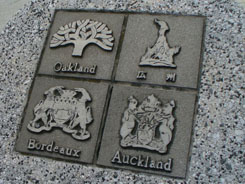
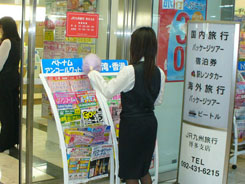
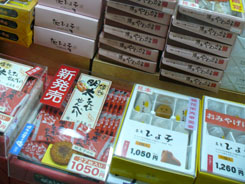
Surprising sites seen around Fukuoka: A tribute to the sister cities. That's normal enough. Dusting the magazines. Okay. Never saw it before that I remember, but it's okay. LOTS of over-packaged food gifts. That's a bit of a surprise. Plastic food displays. I can't quite get used to that. Ramen vending machine - deeply strange. Comic book rental store?? I think we have a winner.
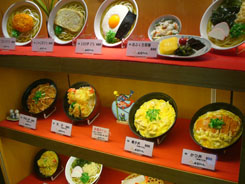
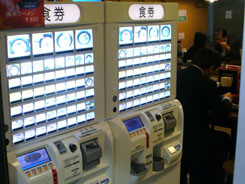
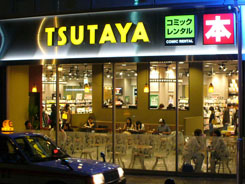
Saturday, April 18, 2009 : Arita, Japan
The over-priced hotel at least features a nice breakfast buffet free with our room. Then we get aboard our train heading for the town of Arita. It's the center of porcelain production in Japan. The techniques were imported to Arita from Korea after the Koreans learned them from the Chinese.
It's nice to get a look at the Japanese countryside. Too bad the Japanese are no more concerned than anybody else about carefully maintaining the side of their property adjacent to railroad tracks. And, like Koreans, they usually dry their laundry on a patio or in front of a window. The train personel give only perfunctory bows on entering and leaving our car. The Korean staff were much superior in this regard and I miss getting those proper bows.
We walk out into the tiny railway station somewhat confused as to where to begin and then, over in the corner, we see a woman beckoning and calling to us. She's at a booth marked "Visitor Information" and she is positively thrilled to see us and to be helpful to us in her excellent English.
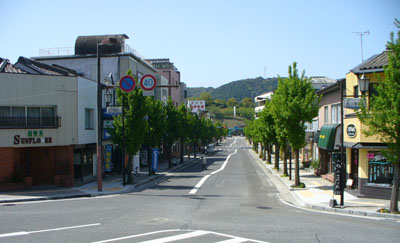
This was our first look at the Japanese town of Arita. During their May festival, this is wall-to-wall people. But not today.
I think this must not be the porcelain season here. She directs us to the nearby porcelain museum. We mention needing an ATM first. She assigns one of the locals to lead us there personally. They're so friendly here in this small town I feel just like I have arrived at Petticoat Junction. Which is not a bad thing.
We find our ATM machine at a tiny post office on a tiny back street. Wonder of wonders, it's got English available (a recorded voice even speaks to us in English) and it lets us take out thousands of Yen. How perfectly bizarre that we had to come to such an unlikely place to get hold of some cash here.
The bad news is Japan is expensive. The good news is they make it impossible actually to spend any money. Rob summarizes Japan's attitude toward outsiders, Bajor for the Bajorans.
We drop into one shop and find the prices are rather a lot higher than we had hoped, and we walk around the quiet little town some more.
The empty parking lot at the Kyushu Ceramics Museum confirms we are out of season but there is one tour bus so at least we are not quite all alone.
Rob is fascinated by the big porcelain clock which performs a show every half hour. We watch it twice. Most of the museum displays are in Japanese, with little or no English provided. We notice that most of the items are secured by wires in the event of an earthquake. Most of the things are just magnificently beautiful.
We buy souvenirs and order tea upstairs. It's the best ever. We are served water, tea, and tiny cookies each in/on gorgeous ceramics. We are tempted to pocket some of it but we restrain ourselves.
We walk in the direction of the local kiln and admire the attractiveness of the town. There's no real sidewalk, just something narrow at the same level as the street.
We walk in to a few more shops and find beautiful expensive things elegantly displayed. Each time, a buzzer announces when we open the door and an old woman appears and turns on the lights. It seems there's nobody else in town. No tourists, anyway. We keep walking.
We come to a shop that looks like a garage with a door at both the front and back. The display here is nowhere near as nice. Just a lot of tables on a cement floor. Prices are much less. We sure are glad we didn't buy anything nearer to the town center. This same garage-shop has an upstairs shop which includes some big art pieces priced as high as $12,000 or 1,200,000 Yen. Figuring the exchange is pretty easy these days. Just drop two zeroes to arrive at the dollar price.
Further on, we come to a shoddy little shop with absolutely nothing to recommend it. This place is even worse than the garage because it has as much stuff crowded into much less space. To pick up anything is to risk three or four other things tumbling and breaking. (There's a kids game based on a similar concept, avoiding a tower of pieces collapsing, but I forget the name of it).
The things we are able to safely extract from the piles are amazing and amazingly cheap. We buy gobs of stuff here. One might suppose that there'd be more English-speakers in such a touristy town as this, but they are nowhere in evidence. Still, we do manage.
On the way back to Fukuoka I take blurry pictures of more back yards and rice fields and laundry. I catch a momentary glimpse of an archery park where people wearing classic Japanese robes are aiming at targets but I'm not quick enough to get a photo of that very cool scene.
Saturday, April 18, 2009 : Fukuoka, Japan
I need more Yen - they go so quickly. I know I can get money at the Post Office but, on impulse, I stop at the front desk and ask them the most convenient location.
She shrugs (ever so very slightly) to indicate that it's a stupid question and says go into any convenience store. I say, no, that doesn't work for foreign cards. She gently suggest that I am mistaken but still accomodates me by asking the other clerks for alternate options. They discuss the matter among themselves at some considerable length until finally I give up and leave and find my own way to the Post Office - evidently the only place in Japan where a non-Japanese bank card will work in the ATM. It has earlier been established that they also do not exchange U.S. dollars and we find little to like about this hotel.
Tonight we're going out on the town with a friend of Rob's, an American who lives nearby and has been teaching at a Japanese school for 7 years. He speaks and writes Japanese fluently. He has already been partying hard today because the archery team at his school won a championship, and it was deemed necessary for everybody at the school to get drunk in celebration. Archery is apparently pretty big here. He also says that although Arita is quiet now, the place will be booming in a few weeks when they have their festival. The "seconds" will be on sale and huge numbers of people will be there. He goes every year and buys gifts for friends and family back home.
He knows we're planning to go to Nagasaki tomorrow, and we talk about that. He says the museum is very, very moving but he also confirms what I've always heard, that the schools here avoid giving students a realistic understanding of events that led up to the bombing. I asked, don't they wonder about it when they grow up and visit Korea, and China, and other nearby countries and the people are all still so angry at them? It is his opinion that the Japanese don't much care.
He says they have no interest in forming any independent view of history, or of much else. The Japanese are good at rote learning, good at doing their homework, but are sadly content generally to "follow the herd." Dangerous.
He mentions the Rape of Nanking early in the war and the military-ordered mass suicide of Japanese civilians on Okinawa near war's end, along with Pearl Harbor and Comfort Women. Japanese generally know next to nothing about those events. But they all know everything about Hiroshima and Nagasaki.
It's a popular restaurant which was recommended by his good friend, and he has made us a reservation. It's called a Yakatori restaurant which he describes as chicken on skewers. Like Thai satay, I guess. Sounds good. We travel there by subway and I notice they have luggage racks here, too. We exit at a building with a sign in English identifying this as Eeny-Meenie-Miny-Mo, which earns a good laugh. Our restaurant is on a narrow back street and on the main floor is a noisy bar.
After greeting the restaurant owner in Japanese and talking about their mutual friend, we are sent up a dark, narrow stairs. Here, we are required to place our shoes into cubicles and we are seated on the floor inside one of the dining rooms which accomodates about 25 people at 6 low tables. Our host has a long exchange with the barefoot waitress while examining an all-Japanese menu while six men in suits get loudly drunk at the next table. This is not a restaurant meant for tourists, which I take as being a good thing for us.
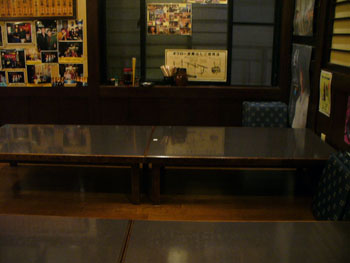
I didn't want to take photos of the other diners, but this is of an empty adjoining dining room. Floor seating.
Yakatori begins with a plate of cabbage leaves. Pretty soon we get our first round of skewers. I immediately forget the description, but it alls sounds harmless. We're drinking Japanese beer, but we also try some Calpis. It's difficult, or maybe impossible, to pronounce the name aloud without raising alarmed eyebrows among English speakers. But it's real good. I like it very much. All is well.
Conversation drifts around to blowfish. About 50 Japanese die every year from eating the wrong part of it. The chef needs a special license but, still, mistakes do happen.
My attention keeps on drifting to the bare feet of the waiters and waitresses who kneel at our table delivering ever more skewers. It seems so odd and I wonder if there isn't a health code violation involved here.
I think I was still open-minded about Yakatori when the bacon-wrapped cheese arrived, and I tried one bite before passing the rest to the host. My patience was certainly all gone by the time the serving of grilled chicken skin was announced because that was the point at which I first refused even to try a dish. Pork gristle got an even quicker pass (Rob is advised to keep chewing and not spit out any of it) and some other type of pork fat derived from inside the foot of a pig. It all just beomes a not-funny horror show and I wish I were anyplace else.
At the next table, they have quieted down a little bit. Our host attributes the fresh calm to the fact they're now being served raw horse meat. I'm quite certain that I've never before heard this item of trivia: Horse is always served raw, never cooked. Some Korean restaurants serve raw horse, too. My cabbage leaves are long gone and I'm thinking how much better I would like this place if we had come for a quick look around and then gone straight to a salad bar restaurant. Our host is talking delightedly about how wonderful this type of food is because you can almost feel your arteries hardening, as if that were a desirable outcome; and he raves about Kobe beef (not red because it's almost 100% pure fat). I wonder how Japanese have such long life-expectancy? My mouth feels like I've been sucking on uncooked bacon.
Dinner is $25 each and I'm pretty sure it's the worst meal that I have ever had anywhere. At least when I was offered baked sheep head in South Africa I'd been warned for weeks to expect it; and I said ahead of time I was not going to eat it. This time I was taken by surprise.
I recommend to all my readers that you have the word Yakatori and the poison symbol tatooed together someplace on your body for convenient reference. One good spot might be near your ankle so you can discreetly lower your sock while seated on the floor of the suspect Japanese restaurant. If you find that you have indeed been tricked into entering this type of restaurant then run, do not walk, to the nearest exit. Remember to grab your shoes on your way out.
We walk through the red light district, which we are assured is among the most notorious in all Japan. Rob and I remember seedy pre-Guliani Times Square and we are not impressed.
We take a cab to another part of town and I am so amazed. You don't open or close the cab door yourself. The driver uses some sort of gadget to operate the left-side door for you. I think it's extremely clever. The right side door, the drivers side, won't open at all.
We visit two different bars which are the size of smallish home kitchens with seating for about 12. They cost us $15 each, which gets you a beer and a few snacks. They're festive.
One of the bars has these chocolate dipped edible sticks. I never saw them before but they're just great and our host says they're available in Walmart with the American name, "pocky." I mean to look for them.
You get a warm damp cloth here when you sit down, just like at the restaurants. And, you get a fresh one when you come back from the restroom. The toilets have a wash basin built right in at the top - anything to conserve precious, expensive floor space.
Somebody asks me (translated by our American host here) if I like whales. I guess because Japan gets so much bad press over that issue. I tell him, yes, I like whales extremely much and I mention admiring the orcas (killer whales) kept at the aquarium in Vancouver. He seems disappointed in me.
I actually hate the way Japan has systematically worked to pillage and destroy all life in the oceans and I feel strongly that something urgently needs to be done to get them to behave responsibly. They're like African poachers only on a far larger scale.
Somehow, the conversation comes around to Japanese school uniforms. They look real good, I think. There's something sort of inspiring about seeing school children in this country, especially when they're bicycling along in little groups. It just looks good to me is all.
Turns out, according to our host, there is an unquenchable hunger here for pornography that involves young women in school uniforms. Another problem is that, with everybody putting their laundry outside to dry, the womens underwear is frequently stolen. Who knows what 'frequently' means in a country with practically no street crime but, anyway, it's a problem.
This particular conversation is over a snack of crackers made from squid ink. The Japanese are strange in many ways.
Sunday April 19, 2009 : Nagasaki, Japan
Next morning, I still feel like my mouth is coated with pig fat and we joke about craving grease for breakfast. Very bad experiences can still make for very good stories. Feel free to adopt mine and avoid the bother (and bad nutrition) of actually experiencing such intolerably bad food for yourself.
We check out of our cramped over-priced hotel and leave the ceramics behind the front desk. We're coming back here tomorrow on our way to our boat back to Busan. Our immediate destination is Isahaya, a town a little ways outside of Nagasaki where a co-worker of Rob at the embassy in Seoul has a house. His wife is Japanese and they are currently vacationing here.
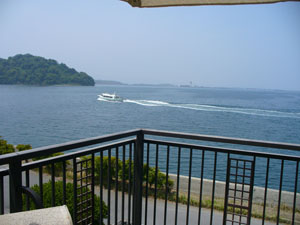
This was our view of Isahaya's bay during lunch. The airport, in the distance, also serves Nagasaki.
He picks us up at the train station and we go to their seaside house and meet the wife. It's a beautiful town, a beautiful house, a beautiful seashore. The wife's family is from Nagasaki. It seems just a little surprising to me that she would happen to end up married to an American. They've been married over 25 years and he doesn't know a word of Japanese.
They live right across the street from Rob on the military base and they're not missing work. They point to the airport across the bay. There's a non-stop flight directly from Seoul. It doesn't get very much more convenient than that. Their 3 adult children are fully bilingual and that also seems to me extremely convenient.
On their balcony overlooking the bay, Rob is in the thrall of some sort of crispy rice cracker which, we are told, is only available in Tokyo. Rob is disapointed to learn that he will not be able to buy any of that here. I concentrate by what's called "yellowcake" and Rob and I are both surprised by its name. We are thinking of uranium. But it's only cake that's yellow. Nagasaki was the place where the Portuguese traders took up residence way long time ago and one thing they introduced was this desert. With some modifications, it's become the special treat from this region of Japan.
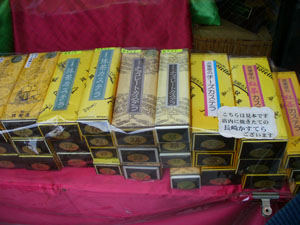
Coming from Nagasaki, if you need gifts, you're supposed to bring this yellow cake.
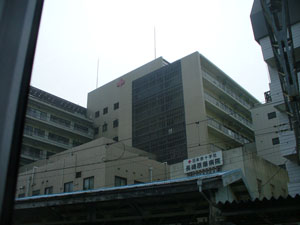
Nagasaki hospital specializing in treatment of those suffering effects of radiation exposure.
Our hosts explain that all the different regions of Japan have their own distinctive foods and when you bring gifts you often bring the special food of the region that you're traveling from. That explains a lot.
Wandering the train station in Fukuoka I saw so many of these food boxes all done up as gifts. So many of them that I was surprised by it. And when I mentioned to the American last night about buying ceramics as gifts, he made a then-baffling comment that I should bring them Japanese food. Now I understand that it's an interesting, and odd, Japanese custom.
I mention that I made Rob watch the film Kagemusha, which concerns shoguns and samurai and such, to get ready for Japan and our hostess heartily approves my choice. We are shown around the house, including "the Japanese room," complete with the matted floor and sliding paper doors. Few Japanese have even one such traditional-style room these days, we are told.
It's about time to go to Nagasaki. Our host tells about one time in the Navy when a sailor was about to step off the boat in Japan wearing a t-shirt that read, "Atomic Weapons. Made in America. Tested in Japan." He was required to change his clothes.
Back on the train, Nagasaki is just a few minutes away. Just before the station, there is a hospital which specialized in treating victims of radiation poisoning. I feel already somewhat solemn about visiting here.
My feeling is that the Japanese now would like to place themselves in history as victims right alongside the countless millions of victims of the Japanese empire all over Asia and the Pacific. Or, ideally, grant themselves such unique and compelling special victim status that those other war crimes pale in comparison. I reject that and I have little patience for anybody anywhere whining to be recognized as somebody else's victim. Even more so when both the alleged victims and their alleged victimizers are generations removed from the actual incidents in question.
I am not aware that Japan's neighbors want anything from Japan now but an acknowledgement of past war crimes. In particular, they want Japanese school children to be taught their real history. It's important to learn history in order to benefit from its lessons. This is little enough to ask.
I think some Japanese want to make sure that everybody never forgets they're the world's only victims of nuclear weapons and, thereby, holders of world history's sympathy trump cards. So I arrive here suspicious of Nagasaki as maybe ground zero in a deranged quest for the world champion victim status.
The moment we step inside the open-air train station all my suspicion of Nagasakians disapates as we encounter a dance competition involving a large number of school dance clubs. It is absolutely perfectly the most delightful thing I've seen in Asia so far.
Each team has unique costumes, some of them have props. All of them have little hand-held things like maraccas, I think they're called, which make a noise when shaken. They're so energetic and exhuberant and fun to watch. A member of a club that's next up steps away from his group to ask Rob where he's from. Rob says Las Vegas and the boy beams with delight. Using his hard-won English to speak with an American who hails from a city that's familiar and interesting to him makes it doubly thrilling, I guess.
After stowing our bags in a storage locker at the station, we take a street car to Chinatown. At one time in the 1800's, Nagasaki's population was about 1/3 Chinese.
From there, it's a brief walk to to where the Dutch maintained a trading station, Dejima, for more than 200 years. Nagasaki was Japan's only window on the rest of the world for hundreds of years when the rest of Japan was "closed" to outsiders and so they're traditionally more cosmopolitan here than anywhere else. The Dutch (and before them, very briefly, the Portuguese) were kept here on a tiny plot of land in the harbor with a moat on all sides. Basically, it was a tightly controlled ghetto, an island prison. The entire settlement has been recreated for tourists.
We walk along the harbor and stop for coffee at a café looking out on the water. Real nice.
Then a quick tour of a museum that seems to have nothing but acres of caligraphy, and it makes no sense to me.
We board the trolley car back to the train station to meet our hotel shuttle. Our host has arranged for us to stay at a very authentic Japanese hotel. I have only a vague notion what to expect.
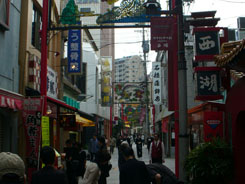
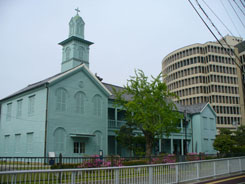
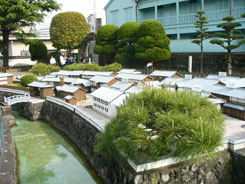
Nagasaki Chinatown. Inside Dejima, the old Dutch Trading Post / Island Prison there is a restored Dutch church. A scale model of Dejima when it was still an isolated island, before they filled in the water surrounding it. The original wall. A Dutch canon they happened to find in the harbor. Dejima still has some water on its perimeter.
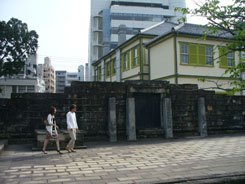
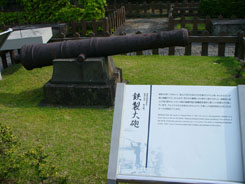
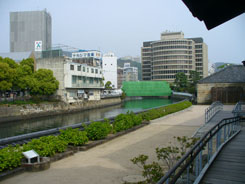
The trolley is crowded because there's an excited sports team here. I ask one of the boys if it's a soccer team. He says, no, it's basketball. I say, oh very good, you know, that's the game President Barack Obama plays. His eyes go wide and he shouts to his teammates and I catch "Obama" amid the stream of Japanese. The whole team roars with delight. It's embarrassing how effortless it is to make a kid's day here.
The shuttle driver picks us up at the train station and takes us up the very steep hillside and pulls into a hotel and says something to us in Japanese. We get out and go to the front desk. We're in the wrong hotel. We got out at the wrong shuttle stop. Somebody from behind the desk runs and fails to catch the shuttle. They put us in a cab. At the correct hotel - which is much nicer - no less than three staff members greet us as we leave the [free] cab. The view of the city from inside the lobby is so magnificent.
And it's even better from our spacious top-floor hotel room.
All the room's doors, both within and at the hallway, are of the Japanese sliding variety. We remove our shoes at the entry area before stepping up onto the wooden floor of the hotel room itself. There are three main rooms with matted floor of some sort, the middle one of which has a low dining table. There are no beds. There are two small chairs. The closets have lots of futons and pillows and stuff.
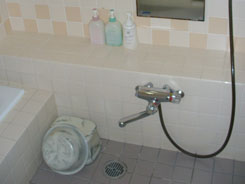
Japanese bath. You're supposed to sit on the one bucket and use the other to pour water over your head. When you're all clean and rinsed, then you can get into the bathtub.
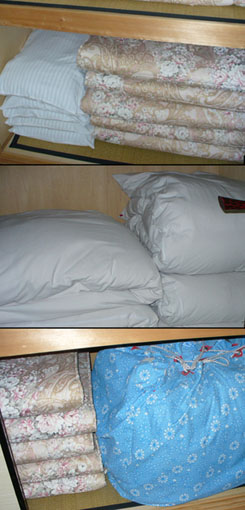
All of the components of the "beds" were kept in a big closet. I could make no sense of how to put it together.
Two staff members show us how to put on the Japanese robes and we are invited to wear them anyplace in the hotel along with the sandals.
There is a shower room which is just completely strange, to me. The whole big room is a shower but you're expected to sit on a plastic platform and use a bucket. There is a bathtub in here, too. Next to it is another room with a normal modern sink and mirror. But something is missing.... I go back outside into one of the main rooms and look suspiciously at the various ceramic bowls... but then I'm glad to find the ultra-modern computerized toilet in yet a different room. It all seems like a wildly inefficient use of space.
Again, there is no Internet.
The saunas are off the downstairs lobby and are open all night, and dinner will be served here in our room in about 90 minutes.
We are so high above the city and we take pictures of the city and of the hawks circling above and below us. It's all magnificent. I see a little train approaching the train station and I experience some déja vue. Nagasaki looks just like Sim City from this vantage!
Of course, we must also try the indoor and outdoor bathing pools. Taking the elevator down in our robes it suddenly occurs to me that I can't remember ever being so nearly naked in an elevator before. My slippers are impossible. Far too small and my normal-size American feet are dangling out the back. The front desk staff know little English but it seems clear they have nothing larger.
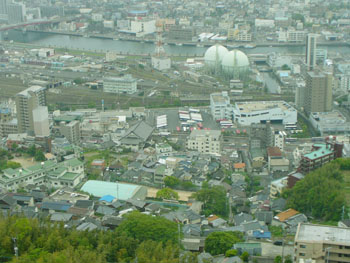
I watched a train progressing slowly along near the water through an industrial area just about directly below... It all gave me a strong sense of looking at Sim City.
We follow the signs and find our way first to the lockers. Just put whatever you want in there and carry the key on a nylon cord on your wrist. Next we stop to read the instructions, The Japanese Way of Taking a Bath, which mainly serve to emphasize that we are to be perfectly clean and rinsed before getting into the shared bathwater. The enormous shallow bathtub is here inside. Outside, past a sliding glass door, is a much smaller Japanese rock garden with a fountain of hot water pouring into it. There's a view of the city far below. Very magnificent. This water is very hot.
Back in the room, they've begun bringing in dinner things. It turns out there are a lot of things. Too many things and too many of the things are looking back at me. But it's all extremely beautiful. Our server is a woman dressed in a completely authentic gown, including that traditional boxy shaped whatsit in the back of her dress. Her movements are so careful as if choreographed. Her presentation of the dinner seems to me all very authentic Japanese... meaning it's all much more stylized than is really quite necessary.
Some of the foods are very good. I pass on all the things that involve sea creatures looking back at me, and a lot of the rest of it to. So many very tiny dishes and in the middle of dinner she arrives with even more of them. So much formality and ceremony and fuss, and what exactly is the point of it all? I find that I do not much appreciate Japanese culture when it's up close and personal.
I'm very relieved when maids appear and assemble our futon beds on the floor. Again, an ordinary bed would have been simpler to manage but the Japanese appear to need to make everything complicated.
Going to sleep on the floor, I imagine all the hotel staff members are home now in their modern apartments in their Lazy Boy recliners watching Hollywood films on their HD TV's.
Monday, April 20, 2009 : Nagasaki Atomic Bomb Museum
Today is the day. There have been lots of interesting sights and experiences in Asia but the two single most highly anticipated moments were, for me, visiting the DMZ and visiting the site of the Nagasaki atomic bomb explosion. And I'm well ready for it because I slept surprisingly well on the floor. There might yet be a little merit to Japanese traditions.
On the hotel shuttle bus to the train station we meet some Japanese-American tourists from Hawaii. I mention that I like Korea better but none of them has ever been there. The one tells me she is four generations removed from Japan and she is afraid of being mistaken by Koreans for a Japanese and they might be hostile to her. Hah! I'm sorry she won't get to enjoy Korea but I do feel some small tingle of vindication that I might be right about the current state of affairs between Japan and its neighbors.
With our bags back in lockers, we easily reach the nearby Nagasaki Atomic Bomb Museum. It's on the same long mountainside where our hotel is located, only a little further inland. The museum is slightly uphill from the precise epicenter of the bomb and it's our first stop. I am disappointed that there is no picture taking allowed inside.
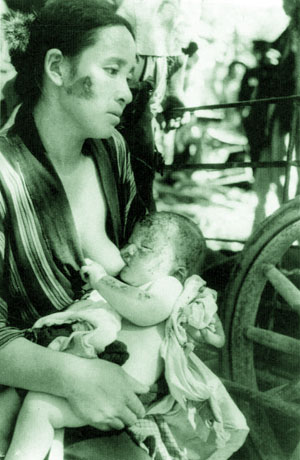
This infant died a few days after this photo was taken while the mother lived another 60 years. The depiction of horrible suffering was very moving.
Among the first points the museum seems to want to make is that Nagasaki was a bad choice of bombing targets. It had far the longest and best history of openness to the world of any Japanese city. And it had the most Christians. There is emphasis on the destruction of a particular church. The mostly Christian USA might ought to have chosen a city that was more traditionally Japanese, I guess. But there was also military ship building in this port city, which argues the other way.
The point is also made that maybe atomic bombs were unnecessary to end the war. That argument has always struck me as thin considering how difficult it was to bring down Okinawa. And the extremely high rate of civilian deaths and suicides there. Extrapolating to Japan's home islands, I think it is reasonable to argue that the nukes actually prevented millions of Japanese deaths.
Japanese society had become totally hopelessly death-oriented (mass murder, mass suicide) and they seemd to prefer death to surrender. There was simply nothing else to be done with them.
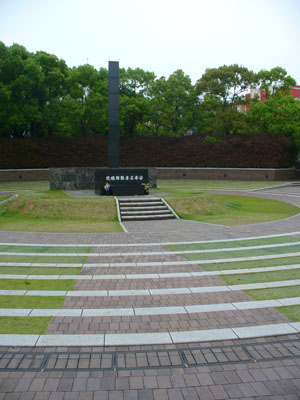
This simple black marker is where the atomic bomb exploded 1500 feet above. 40,000 people died immediately. The total death toll reached 80,000 by year's end.
They should stick to their best argument which is that maybe the Hiroshima bomb was sufficient and the bombing of Nagasaki was gratuitous. But even that argument has some serious problems.
One display claims that the cost of the Manhattan Project was greater than Japan's entire national budget for one year and the powers-that-be in Washington felt it was necessary to show a return on investment. Somebody had to get nuked in order to prove it all worthwhile. And the USA needed to scare the Soviets just as the Cold War was getting started. I am not impressed by these arguments.
Nagasaki was not actually the primary target. The bomb was supposed to be exploded over another city but it had poor visibility. The plane then came here, the second choice, and found similar difficulty. They were stuck then, circling overhead and undecided what to do, when suddenly there was a brief break in the clouds over Nagasaki and... kaboom.
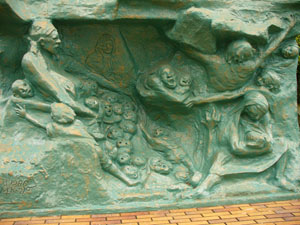
Sculpture depicting the horrors of war. The Japanese had a very much higher opinion of war in general and this war they started, in particular, as long as they were winning.
A clock forever stopped at 11:02 AM reminds me of one I saw at the gate of Buchenwald, a concentration camp outside of Weimar, Germany which also got stopped by the United States military just four months earlier. A stack of coins melted together by the intense heat also impresses me. As bad as the bomb and the radiation were, there was additional devastation owing to countless out-of-control fires that burned here. The force of the explosion spread out from the center with a speed more than double that of the most powerful typhoon.
A three dimensional floor display is very impressive. It's a 15-foot wide circular scale model representation of the entire city, including the bay, the harbor, the valley, and the mountains. As the video describes the horrifying events of that day, lights within the display are used to indicate the points and the regions being referred to. It's so hard to square the utter devestation being described with the big, prosperous, vibrant city outside; hard to grasp that they're the same place. But this display helps.
There is a precise replica of Fat Man, the bomb that was dropped here. It's not quite as famous as Little Boy.
Further along, the exhibits concentrate on all the terrible human suffering that followed here from radiation and from burns. One famous picture is of a woman nursing an infant. The mother looks so vacant. The child is days from death. And there are personal stories from survivors which are all very sad. Much is made of the fact that hospitals and schools were destroyed - not legitimate military targets.
They are taking this awful day far outside of its proper context. The war crimes of the Japanese Empire include MILLIONS of innocent children murdered and orphaned and the Japanese cared nothing for their suffering. Japanese soldiers flung infants into the air and caught them on the point of their bayonettes. And laughed at the mothers' anguish. I imagine a fair share of the soldiers who committed those atrocities were from right around here and, probably, they never imagined that what goes around really might one day come around.
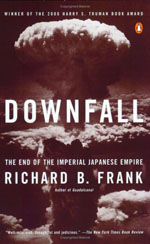
The book Downfall by Richard B. Frank is reportedly an excellent history of the final days of the Japanese Empire. (click the image to link to it at Amazon.com)
Near the end is a display which, at last, shows the historical context. But it's only videos on individual display screens where you sit and watch them one after another and they tell the history of the war. We don't have time to watch them all but they seem to be about fair.
This is a museum about the bombing and not about the war, but these several screens still seem to me less than sufficient and too easily skipped entirely. Yes, it is truly terrible about that mother and her baby. It really, really is. There were millions more such scenes every bit as terrible, death, destruction and misery on a massive scale, and those Japanese crimes were what made this day necessary. And they don't get nearly the same treatment here.
There were thousands of Koreans killed by the two atomic bombs but if they were mentioned anyplace here then I missed it. I expect it would be awkward to explain the Koreans' presence to Japanese schoolchildren as they were here as their great-grandparents' slaves.
Finally, there are some more exhibits about the history of nuclear weapons development, anti-nuclear protests, test ban treaties, and nuclear non-proliferation treaties. The message here is, no more Nagasakis. But I wonder... what if some malevolent and powerful nation conquered Japan, wrecked its cities, murdered its people, and made sex slaves of tens of thousands of Japanese women for the pleasure of the soldiers of the conquering power, if the Japanese might not possibly consider that a nuke or two could be just what's needed to put things right....
Outside it's raining slightly while we walk down the hill to the Peace Park. It's got monuments that were gifts from various nations. No more Nagasakis. We're rushing now. If we miss the train then we miss the boat to Korea this afternoon. We also visit the black monument which marks the exact spot above which the big one exploded.
I'm very glad to have visited here. Nagasaki is a beautiful and interesting city. But I'm real tired of Japan. I want to go back to Korea.
And the train ride to Fukuoka and the boat ride to Busan are uneventful. There's a powerful storm with high winds and torrential rain when we arrive at the Busan dock in the early evening.
